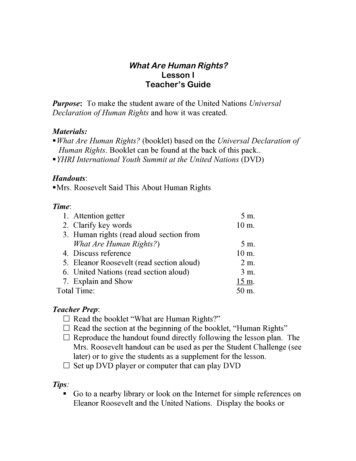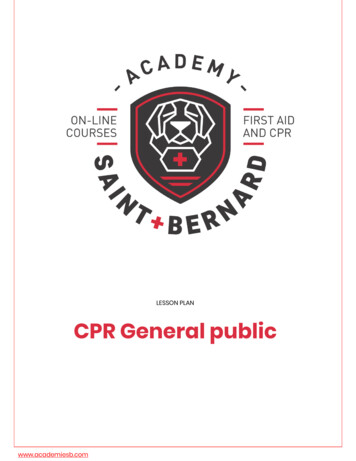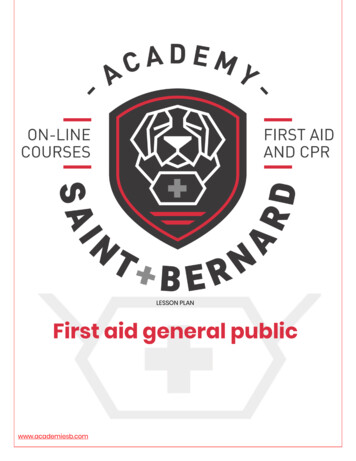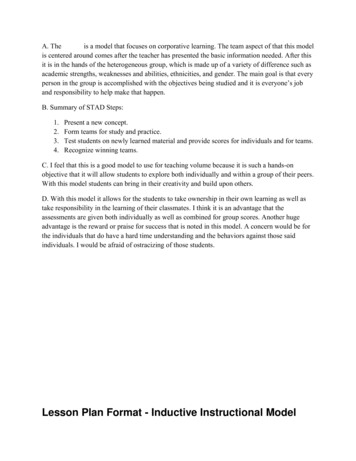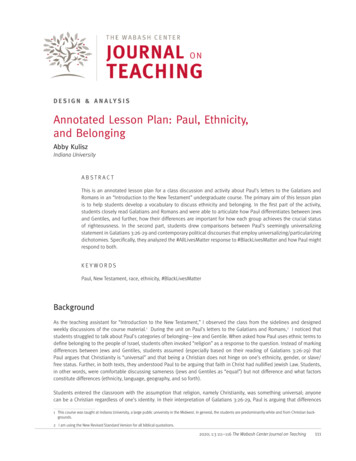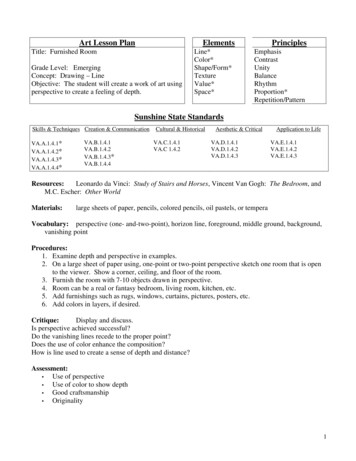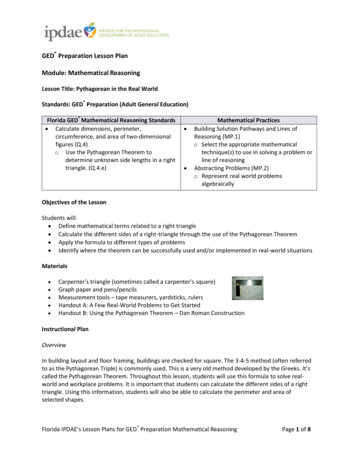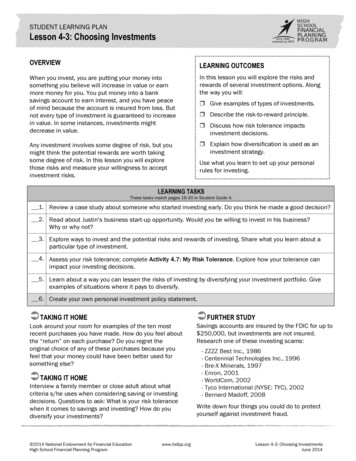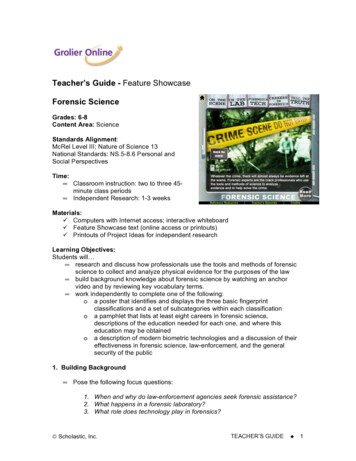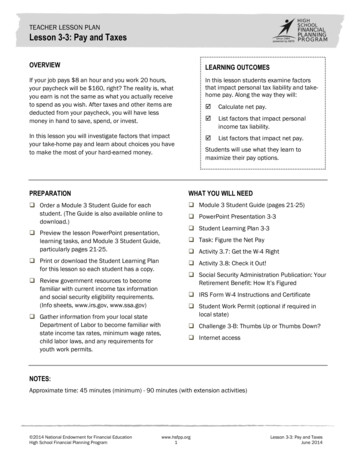
Transcription
TEACHER LESSON PLANLesson 3-3: Pay and TaxesOVERVIEWLEARNING OUTCOMESIf your job pays 8 an hour and you work 20 hours,your paycheck will be 160, right? The reality is, whatyou earn is not the same as what you actually receiveto spend as you wish. After taxes and other items arededucted from your paycheck, you will have lessmoney in hand to save, spend, or invest.In this lesson students examine factorsthat impact personal tax liability and takehome pay. Along the way they will:In this lesson you will investigate factors that impactyour take-home pay and learn about choices you haveto make the most of your hard-earned money. Calculate net pay. List factors that impact personalincome tax liability. List factors that impact net pay.Students will use what they learn tomaximize their pay options.PREPARATIONWHAT YOU WILL NEED Order a Module 3 Student Guide for eachstudent. (The Guide is also available online todownload.) Module 3 Student Guide (pages 21-25) Preview the lesson PowerPoint presentation,learning tasks, and Module 3 Student Guide,particularly pages 21-25. PowerPoint Presentation 3-3 Student Learning Plan 3-3 Task: Figure the Net Pay Activity 3.7: Get the W-4 Right Print or download the Student Learning Planfor this lesson so each student has a copy. Activity 3.8: Check it Out! Review government resources to becomefamiliar with current income tax informationand social security eligibility requirements.(Info sheets, www.irs.gov, www.ssa.gov) IRS Form W-4 Instructions and Certificate Gather information from your local stateDepartment of Labor to become familiar withstate income tax rates, minimum wage rates,child labor laws, and any requirements foryouth work permits. Social Security Administration Publication: YourRetirement Benefit: How It’s Figured Student Work Permit (optional if required inlocal state) Challenge 3-B: Thumbs Up or Thumbs Down? Internet accessNOTES:Approximate time: 45 minutes (minimum) - 90 minutes (with extension activities) 2014 National Endowment for Financial EducationHigh School Financial Planning Programwww.hsfpp.org1Lesson 3-3: Pay and TaxesJune 2014
TEACHER LESSON PLANLesson 3-3: Pay and TaxesLearning Tasks1. If Kevin earns 6.50 an hourand worked 60Teaching NotesPROCEDUREMaterialsTIME ESTIMATE: 10 minutes [Slide 2] Before showing the students Activity 3.8, tell them to calculatehow much Kevin earned and compare their answers with a neighbor. Askthe students if he will receive all of that money when he cashes hishow much did heearn for the entire paycheck. When student responds that he won’t receive all of the earnings,ask for reasons why his actual “take-home pay” is less than what hemonth? CompleteActivity 3.8: Check earned. Reference the responses later in the lesson as you discuss payrolldeductions.it Out! to see howhours last month,much money heactually tookhome. Wrap up this task by having the students complete Activity 3.8: Check itOut, either individually or as a whole class. Point out that “Net Pay” is theactual “take-home pay” that Kevin has available to use as he wishes forsaving, investing, or spending. [Slide 3] Transition into the lesson preview by noting that although Kevinis required to pay income taxes on earnings, he does have some control indeciding how much he receives in net pay. Preview the Learning Outcomesin the Student Learning Plan. By the end of this lesson, the students shouldbe able to investigate factors that impact their take-home pay and learnabout choices they have to maximize their pay options.2. What do youknow abouttaxes? Participatein a discussion onhow taxes arepaid. Thenbrainstormreasons why weneed to pay taxes.PROCEDURETIME: 10 minutes Begin a discussion about income tax deductions. If the students haveprevious experience with income taxes, ask them to share what they knowabout the types of income taxes paid by workers and why workers paytaxes. Use Slide 4 and page 21 to introduce or review the types of incometaxes and fill in gaps for how the taxes are calculated. Use Slide 5 to differentiate between income taxes and FICAcontributions. Point out that the students are already saving for theirretirement when they have Social Security and Medicare contributionsdeducted from their paychecks. This money is pooled in a fund todistribute to eligible retirees, survivors of workers who have died, andpeople who are disabled. Employers add to the pool by matching employeecontributions. Retirement benefits are based on the average indexedmonthly earnings during a worker’s 35 years of highest earnings before age62. So, it pays to stay in the workforce and increase earnings over time.Additional information is available at www.ssa.gov. An information sheet isalso provided to explain how Social Security benefits are figured. 2014 National Endowment for Financial EducationHigh School Financial Planning Programwww.hsfpp.org2Module 3Student GuideStudent LearningPlanSTUDENT GUIDEPage 24SLIDES2 – Kevin’sPaycheck3 - PreviewACTIVITYActivity 3.8:Check it Out!Calculators(optional)STUDENT GUIDEPages 21-22SLIDES4 – Income Taxfor Individuals5 – SocialSecurity &MedicareContributionsACTIVITIESSocial SecurityAdministrationPublication: YourRetirementBenefits: How It’sFigured(optional)Internet access:www.IRS.govwww.ssa.govLesson 3-3: Pay and TaxesJune 2014
TEACHER LESSON PLANLesson 3-3: Pay and TaxesLearning TasksTeaching NotesMaterials Ask the students, “How do we pay income taxes?” Allow one or twominutes for responses before telling them that as workers, they get tochoose the method for paying taxes: a little at a time out of each paycheck(withholding) or all at once (after calculating exactly what is owed filingtaxes). Point out that having taxes withheld from each paycheck is a way tohelp workers set aside funds at regular intervals for their tax liabilities,much like when they create a spending plan to regularly set aside funds forsavings goals and occasional expenses such as insurance.EXTENSION: If this is a new concept for students, use one of the manylesson plans available on the IRS educator sp3. Find out thefinancial decisionsyou need toPROCEDURETIME: 10 minutes Ask students to share their experiences about what paperwork they hadto fill out when they started new jobs. Fill in gaps by explaining whatstarting a new job. documentation is often required of new hires, including proof of citizenship,emergency contact information, payroll preferences (i.e. deductions,Make one of yourfirst adult financial automatic deposit option), insurance applications or waivers, employeepolicy/handbook acknowledgement, and in some states, a youth workdecisions whenpermit. [Slide 6] Point out financial decisions that will need to be addressedyou fill out an IRSwhen accepting and starting a new job. As time allows, elaborate on theseForm W-4.decisions or share personal stories about the decisions.address when [Slide 7] Read through the Student Guide text (page 22) with students.Make sure they understand the choices they have to make when filling outan IRS Employee’s Withholding Allowance Certificate (Form W-4). Explainthat deciding what to claim for allowances is a financial decision they willmake every time they fill out the form. What they record in lines 3, 5, 6, and7 will impact the amount of federal income tax that is deducted from theirgross pay. Guide students as they complete Activity 3.7: Get the W-4 Right.Note: IRS Form W-4 (2015) is provided for reference. Ideally, a workershould claim withholding allowances in such a way that a sufficient amountof taxes should be withheld throughout the year to avoid the need to comeup with a big chunk of money to pay additional income taxes owed at theend of the year. Reversely, there should not be too much withheld so alarge refund is received when filing taxes—this is money a person couldhave had in hand for saving, investing, or spending rather than having itheld by the government during the year. (This is a good time to review howthe time value of money applies in this situation if you have already coveredthe concept in Module 4: Investing.) 2014 National Endowment for Financial EducationHigh School Financial Planning Programwww.hsfpp.org3STUDENT GUIDEPages 22-23SLIDES6 – FinancialDecisions WhenStarting a Job7 – W-4WithholdingCertificate8 – Youth WorkPermitsACTIVITIESActivity 3-7: Getthe W-4 RightIRS Form W-4with instructionsStudent WorkPermit (ifapplicable inyour state)Internetwww.irs.govLesson 3-3: Pay and TaxesJune 2014
TEACHER LESSON PLANLesson 3-3: Pay and TaxesLearning TasksTeaching NotesMaterialsExplanation: Most people who are single and have no children will claimeither “0,” “1,” or “2” allowances on their W-4 form. With a higher numberof allowances claimed, a lower amount of income taxes will be withheldfrom paychecks. Someone who expects to not owe any income tax, such asa student who works short-term in the summer, might claim “exempt” onthe W-4 Certificate to increase the net pay received each paycheck ratherthan wait for a tax refund at the end of the year. However, an employeeneeds to make sure to have enough money to cover any taxes owed whentaxes are due on April 15. The most convenient way to plan for taxpayments is to pay a little at a time from each paycheck rather than all atonce at the end of the year. [Slide 8 - optional if your state requires Youth Work Permits] If workpermits are required in your state, provide an explanation of how to get apermit. Point out that the purpose of a child labor work permit is to ensurethat all parties (student, employer, and parent) comply with minimum ageemployment restrictions. Additional information about work permits andchild labor laws can be found at your state’s Labor Department website andthe U.S. Department of Labor tsagecert.htm.Additional Resources:4. Congratulations!You are nowearning 30,000a year. Calculateyour net, or takehome, pay. Department of Revenue video, “Teens 'n Taxes What's a W-4 form?”(1 minute, 48 seconds). Use either the YouTubeTM link,www.youtube.com/watch?v oKLtwk Jh6o, or the DOR website -and-militarypersonnel/students/ IRS W-4 Form, www.irs.gov/pub/irs-pdf/fw4.pdf 360 Degrees of Financial Literacy, IRS.gov, a free program of thenation’s certified public accountants, www.360financialliteracy.org/Topics/ Taxes/Income-Tax NEFE’s CashCourse website, www.cashcourse.org. Students andInstructors who are not affiliated with a college or university can registeras “Other” to access CashCourse and utilize the site resources.PROCEDURETIME: 10 minutes [Slide 9] Distribute the Figure the Net Pay task and preview thedirections for each situation. Arrange for students to work individually or inpairs to complete calculations for each situation. (Note: Retirement fundinvesting and contributions are covered more in depth in Module 4:Investing, but this is a good time to point out how pre-tax deductions impactnet pay and tax liability.) 2014 National Endowment for Financial EducationHigh School Financial Planning Programwww.hsfpp.org4SLIDE9 – What is YourNet Pay?ACTIVITYTask: Figure theNet PayCalculators(optional)Lesson 3-3: Pay and TaxesJune 2014
TEACHER LESSON PLANLesson 3-3: Pay and TaxesLearning TasksTeaching NotesMaterials Debrief by asking the students to react to the scenario differences,specifically the tax liability, net pay, and retirement fund contributions. Askthe students what they think is a good course of action when they receive araise or bonus “windfall.” Point out that having a plan in advance can helpthem be in control with how their money is used.Extension: The Federal, Social Security, and Medicare tax information provided forthis exercise are the rates for the 2015 tax year. Have students go tothe IRS website (www.irs.gov) to research the additional informationabout current tax rates and calculations. The state withholding rate provided is for Colorado. Have studentslook up the tax rate for their own state. (Try a website likewww.taxadmin.org/fta/rate/tax stru.html) Students can also analyze the impact being married has on taxwithholdings. Students can research dues related to their possible career fields andcompare the costs of dues.Additional Learning Resources provided by NEFE: www.cashcourse.org articles about taxes and paycheck deductions5. CompleteChallengeAssignment 3-B:Thumbs Up orThumbs Down? toidentify potentialjob options andpayroll optionsthat match yourpreferences.PROCEDUREIn-class or out-of-class assignment Assign the students to complete Challenge 3-B: Thumbs Up or ThumbsDown. This Challenge is appropriate to assign with this lesson or aftercompleting Lesson 3-2 or Lesson 3-4.www.hsfpp.org5SLIDE10 - ChallengeACTIVITYResource: This is a good time to introduce students, particularly students inGrades 11-12, to the CashCourse Prep website, www.cashcourse.org/prep.Here they will find helpful resources such as a Job Priorities worksheet anda Job Comparison worksheet. Students and Instructors who are notaffiliated with a college or university can register as “Other” to accessCashCourse and utilize the site resources. 2014 National Endowment for Financial EducationHigh School Financial Planning ProgramSTUDENT GUIDEPage 29Challenge 3-B:Thumbs Up orThumbs DownLesson 3-3: Pay and TaxesJune 2014
TEACHER LESSON PLANLesson 3-3: Pay and TaxesLearning TasksTeaching NotesMaterialsTAKING IT HOMEPROCEDURETake a close look Encourage students who have been or are employed to closely examineat one of yourone of their recent paystubs to become familiar with the informationrecorded by the employer. Stress the importance of verifying payrollinformation to ensure accuracy. Explain that this information should bekept to confirm year-end data when the students receive their W-2 Wageand Tax Statement at the end of each year. It is the employee’sresponsibility to ensure that all information is documented accurately.recent paystubs tosee how payrollinformation isrecorded.Out-of-class assignmentREFLECTIONPROCEDUREIn-class or out-of-class assignmentThink about whatallowances youmight record on aW-4 Form whenyou life situationchanges. Guide the students to reflect on what they might record on an IRS W-4Certificate in the future when they have a full-time job, if they are marriedand their spouse works full time, and if they have children. TAKING IT HOMETake a close look at one of your recent paystubs to see how payroll information is recorded. Keep yourpaystubs to match up data on the W-2 Wage and Tax Statement you receive from your employer at the end ofthe year. This information is needed when filing your income taxes, and your total wages are also tracked forfuture Social Security benefits. REFLECTIONThink about the number of W-4 allowances you think best reflects your needs right now. Now, imagineinto the future and indicate how you would change your number of allowances for each of the followingscenarios and why. You accept your first full-time job. You just got married and your spouse also works full-time. Your first child was just born. FURTHER STUDYPractice filling out an income tax form. You can find simulations for several situations on the IRS.govUnderstanding Taxes Student Site, www.irs.gov/app/understandingtaxes/index.jsp 2014 National Endowment for Financial EducationHigh School Financial Planning Programwww.hsfpp.org6Lesson 3-3: Pay and TaxesJune 2014
High School Financial Planning Program 2014 National Endowment for Financial Education www.hsfpp.orgLesson 3-3: Pay andTaxes0
High School Financial Planning ProgramLesson 3-3: Pay and Taxes Display this slide as you prepare to introduce this lesson. 2014 National Endowment for Financial Education www.hsfpp.org1
High School Financial Planning ProgramLesson 3-3: Pay and TaxesStudent Guide, page 24 Before showing the students Activity 3.8, tell them to calculate how much Kevinearned and compare their answers with a neighbor. Ask the students if he will receiveall of that money when he cashes his paycheck. When student responds that he won’treceive all of the earnings, ask for reasons why his actual “take-home pay” is lessthan what he earned. Reference the responses later in the lesson as you discusspayroll deductions. Wrap up this task by having the students complete Activity 3.8: Check it Out, eitherindividually or as a whole class. Point out that “Net Pay” is the actual “take-home pay”that Kevin has available to use as he wishes for saving, investing, or spending. 2014 National Endowment for Financial Education www.hsfpp.org2
High School Financial Planning ProgramLesson 3-3: Pay and Taxes Transition into the lesson preview by noting that although Kevin is required to payincome taxes on earnings, he does have some control in deciding how much hereceives in net pay. Preview the Learning Outcomes in the Student Learning Plan. Bythe end of this lesson, the students should be able to investigate factors that impacttheir take-home pay and learn about choices they have to maximize their pay options. 2014 National Endowment for Financial Education www.hsfpp.org3
High School Financial Planning ProgramLesson 3-3: Pay and TaxesStudent Guide, pages 21-22 Begin a discussion about income tax deductions. If the students have previousexperience with income taxes, ask them to share what they know about the types ofincome taxes paid by workers and why workers pay taxes. Use this slide and page 21to introduce or review the types of income taxes and fill in gaps for how the taxes arecalculated. 2014 National Endowment for Financial Education www.hsfpp.org4
High School Financial Planning ProgramLesson 3-3: Pay and TaxesStudent Guide, pages 21-22 Use this slide to differentiate between income taxes and FICA contributions. Point out that thestudents are already saving for their retirement when they have Social Security and Medicarecontributions deducted from their paychecks. This money is pooled in a fund to distribute toeligible retirees, survivors of workers who have died, and people who are disabled. Employersadd to the pool by matching employee contributions. Retirement benefits are based on theaverage indexed monthly earnings during a worker’s 35 years of highest earnings before age62. So, it pays to stay in the workforce and increase earnings over time.Additional Information: Social Security Administration Publication: Your Retirement Benefit: How It’s Figured www.ssa.gov Ask the students, “How do we pay income taxes?” Allow one or two minutes for responsesbefore telling them that as workers, they get to choose the method for paying taxes: a little at atime out of each paycheck (withholding) or all at once (after calculating exactly what is owedfiling taxes). Point out that having taxes withheld from each paycheck is a way to help workersset aside funds at regular intervals for their tax liabilities, much like when they create aspending plan to regularly set aside funds for savings goals and occasional expenses such asinsurance.EXTENSION: If this is a new concept for students, use one of the many lesson plans available onthe IRS educator website: www.irs.gov/app/understandingTaxes/index.jsp 2014 National Endowment for Financial Education www.hsfpp.org5
High School Financial Planning ProgramLesson 3-3: Pay and TaxesStudent Guide, pages 22-23 Ask students to share their experiences about what paperwork they had to fill outwhen they started new jobs. Fill in gaps by explaining what documentation is oftenrequired of new hires, including proof of citizenship, emergency contact information,payroll preferences (i.e. deductions, automatic deposit option), insurance applicationsor waivers, employee policy/handbook acknowledgement, and in some states, ayouth work permit. Point out financial decisions that will need to be addressed when accepting andstarting a new job.
have had in hand for saving, investing, or spending rather than having it held by the government during the year. (This is a good time to review how the time value of money applies in this situation if you have already covered the concept in Module 4: Investing.) STUDENT GUIDE Pages 22-23
